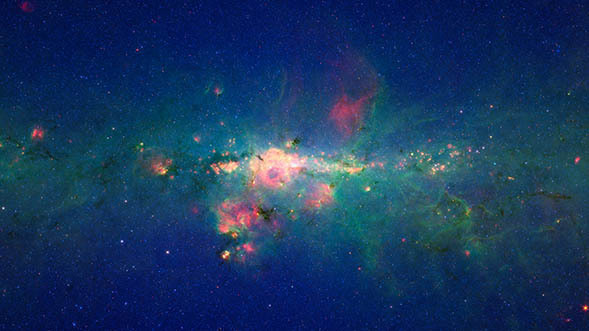
The Galactic Center, captured by Spitzer's Infrared Array Camera
Credit: NASA/JPL-Caltech/S. Stolovy
Spitzer's redesign benefited greatly from the dramatic technological developments made in infrared detectors and lightweight optics.
In the 1980s the US Department of Defense invested hundreds of millions of dollars in infrared detectors. As the accumulated knowledge filtered through to the civilian world, astronomers pushed the focus of development towards low-background, high-sensitivity applications suitable for astronomical observation.
In the span of fifteen years, infrared astronomers went from using a handful of individual detector pixels to routinely working with large-format arrays of many thousands of pixels. The groundbreaking Infrared Astronomical Satellite (IRAS) relied on detectors with only 62 pixels, whereas Spitzer's Infrared Array Camera used over 65000 pixels per detector, which are considered small by modern standards.
In addition to detector improvements, Spitzer also benefited from a revolution in lightweight optics, which reduced the weight of the Observatory and its launch costs. Spitzer's supporting structure, primary and secondary telescope mirrors were made almost entirely from beryllium.
Beryllium is extremely light but very strong - the telescope itself weighs less than 50 kilograms (110 pounds). This material also has a low heat capacity at very low temperatures, which means it cools quickly and efficiently. Thus, it is ideal for infrared telescope design.
It is important for as much of the telescope as possible to be built from a single type of material, because different materials expand and contract by different amounts as they heat up and cool down. Building the telescope out of different materials could cause it to flex out of shape as it changes temperature, putting extra stress on the joints and causing the telescope to go out of focus.



